Junfeng Wu
TokBench: Evaluating Your Visual Tokenizer before Visual Generation
May 26, 2025Abstract:In this work, we reveal the limitations of visual tokenizers and VAEs in preserving fine-grained features, and propose a benchmark to evaluate reconstruction performance for two challenging visual contents: text and face. Visual tokenizers and VAEs have significantly advanced visual generation and multimodal modeling by providing more efficient compressed or quantized image representations. However, while helping production models reduce computational burdens, the information loss from image compression fundamentally limits the upper bound of visual generation quality. To evaluate this upper bound, we focus on assessing reconstructed text and facial features since they typically: 1) exist at smaller scales, 2) contain dense and rich textures, 3) are prone to collapse, and 4) are highly sensitive to human vision. We first collect and curate a diverse set of clear text and face images from existing datasets. Unlike approaches using VLM models, we employ established OCR and face recognition models for evaluation, ensuring accuracy while maintaining an exceptionally lightweight assessment process <span style="font-weight: bold; color: rgb(214, 21, 21);">requiring just 2GB memory and 4 minutes</span> to complete. Using our benchmark, we analyze text and face reconstruction quality across various scales for different image tokenizers and VAEs. Our results show modern visual tokenizers still struggle to preserve fine-grained features, especially at smaller scales. We further extend this evaluation framework to video, conducting comprehensive analysis of video tokenizers. Additionally, we demonstrate that traditional metrics fail to accurately reflect reconstruction performance for faces and text, while our proposed metrics serve as an effective complement.
AquaticVision: Benchmarking Visual SLAM in Underwater Environment with Events and Frames
May 06, 2025Abstract:Many underwater applications, such as offshore asset inspections, rely on visual inspection and detailed 3D reconstruction. Recent advancements in underwater visual SLAM systems for aquatic environments have garnered significant attention in marine robotics research. However, existing underwater visual SLAM datasets often lack groundtruth trajectory data, making it difficult to objectively compare the performance of different SLAM algorithms based solely on qualitative results or COLMAP reconstruction. In this paper, we present a novel underwater dataset that includes ground truth trajectory data obtained using a motion capture system. Additionally, for the first time, we release visual data that includes both events and frames for benchmarking underwater visual positioning. By providing event camera data, we aim to facilitate the development of more robust and advanced underwater visual SLAM algorithms. The use of event cameras can help mitigate challenges posed by extremely low light or hazy underwater conditions. The webpage of our dataset is https://sites.google.com/view/aquaticvision-lias.
Bias-Eliminated PnP for Stereo Visual Odometry: Provably Consistent and Large-Scale Localization
Apr 24, 2025Abstract:In this paper, we first present a bias-eliminated weighted (Bias-Eli-W) perspective-n-point (PnP) estimator for stereo visual odometry (VO) with provable consistency. Specifically, leveraging statistical theory, we develop an asymptotically unbiased and $\sqrt {n}$-consistent PnP estimator that accounts for varying 3D triangulation uncertainties, ensuring that the relative pose estimate converges to the ground truth as the number of features increases. Next, on the stereo VO pipeline side, we propose a framework that continuously triangulates contemporary features for tracking new frames, effectively decoupling temporal dependencies between pose and 3D point errors. We integrate the Bias-Eli-W PnP estimator into the proposed stereo VO pipeline, creating a synergistic effect that enhances the suppression of pose estimation errors. We validate the performance of our method on the KITTI and Oxford RobotCar datasets. Experimental results demonstrate that our method: 1) achieves significant improvements in both relative pose error and absolute trajectory error in large-scale environments; 2) provides reliable localization under erratic and unpredictable robot motions. The successful implementation of the Bias-Eli-W PnP in stereo VO indicates the importance of information screening in robotic estimation tasks with high-uncertainty measurements, shedding light on diverse applications where PnP is a key ingredient.
SCORE: Saturated Consensus Relocalization in Semantic Line Maps
Mar 05, 2025



Abstract:This is the arxiv version for our paper submitted to IEEE/RSJ IROS 2025. We propose a scene-agnostic and light-weight visual relocalization framework that leverages semantically labeled 3D lines as a compact map representation. In our framework, the robot localizes itself by capturing a single image, extracting 2D lines, associating them with semantically similar 3D lines in the map, and solving a robust perspective-n-line problem. To address the extremely high outlier ratios~(exceeding 99.5\%) caused by one-to-many ambiguities in semantic matching, we introduce the Saturated Consensus Maximization~(Sat-CM) formulation, which enables accurate pose estimation when the classic Consensus Maximization framework fails. We further propose a fast global solver to the formulated Sat-CM problems, leveraging rigorous interval analysis results to ensure both accuracy and computational efficiency. Additionally, we develop a pipeline for constructing semantic 3D line maps using posed depth images. To validate the effectiveness of our framework, which integrates our innovations in robust estimation and practical engineering insights, we conduct extensive experiments on the ScanNet++ dataset.
UniTok: A Unified Tokenizer for Visual Generation and Understanding
Feb 27, 2025Abstract:The representation disparity between visual generation and understanding imposes a critical gap in integrating these capabilities into a single framework. To bridge this gap, we introduce UniTok, a discrete visual tokenizer that encodes fine-grained details for generation while also capturing high-level semantics for understanding. Despite recent studies have shown that these objectives could induce loss conflicts in training, we reveal that the underlying bottleneck stems from limited representational capacity of discrete tokens. We address this by introducing multi-codebook quantization, which divides vector quantization with several independent sub-codebooks to expand the latent feature space, while avoiding training instability caused by overlarge codebooks. Our method significantly raises the upper limit of unified discrete tokenizers to match or even surpass domain-specific continuous tokenizers. For instance, UniTok achieves a remarkable rFID of 0.38 (versus 0.87 for SD-VAE) and a zero-shot accuracy of 78.6% (versus 76.2% for CLIP) on ImageNet. Our code is available at https://github.com/FoundationVision/UniTok.
Liquid: Language Models are Scalable Multi-modal Generators
Dec 05, 2024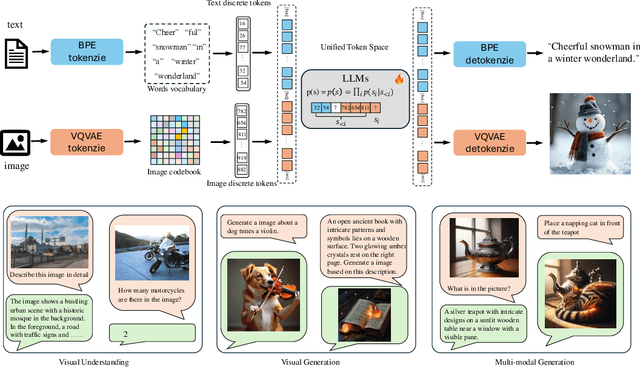
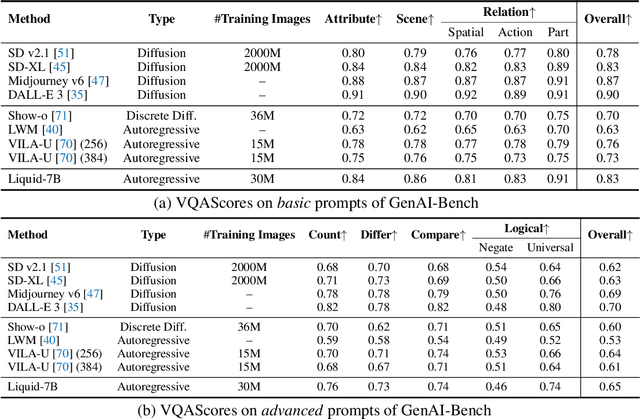
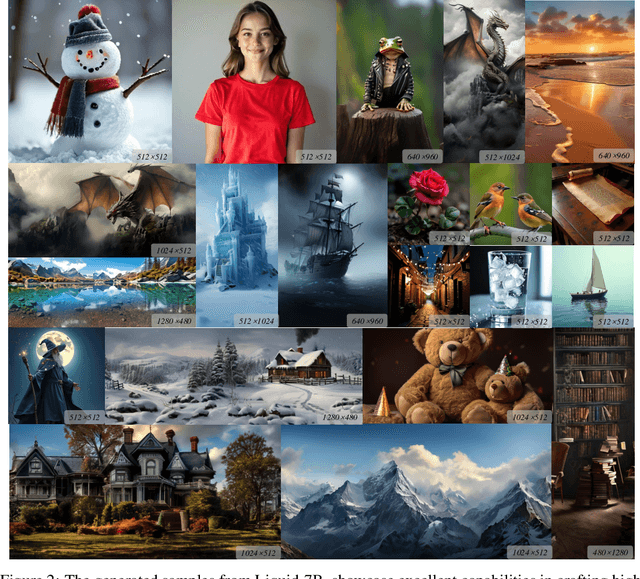
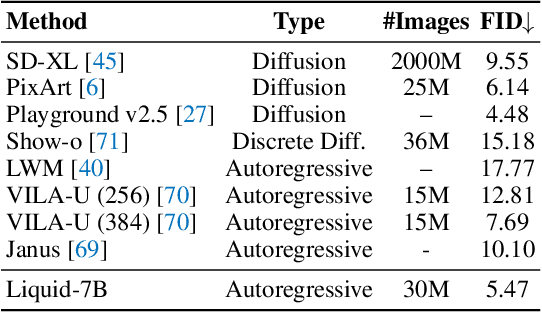
Abstract:We present Liquid, an auto-regressive generation paradigm that seamlessly integrates visual comprehension and generation by tokenizing images into discrete codes and learning these code embeddings alongside text tokens within a shared feature space for both vision and language. Unlike previous multimodal large language model (MLLM), Liquid achieves this integration using a single large language model (LLM), eliminating the need for external pretrained visual embeddings such as CLIP. For the first time, Liquid uncovers a scaling law that performance drop unavoidably brought by the unified training of visual and language tasks diminishes as the model size increases. Furthermore, the unified token space enables visual generation and comprehension tasks to mutually enhance each other, effectively removing the typical interference seen in earlier models. We show that existing LLMs can serve as strong foundations for Liquid, saving 100x in training costs while outperforming Chameleon in multimodal capabilities and maintaining language performance comparable to mainstream LLMs like LLAMA2. Liquid also outperforms models like SD v2.1 and SD-XL (FID of 5.47 on MJHQ-30K), excelling in both vision-language and text-only tasks. This work demonstrates that LLMs such as LLAMA3.2 and GEMMA2 are powerful multimodal generators, offering a scalable solution for enhancing both vision-language understanding and generation. The code and models will be released.
Online Poisoning Attack Against Reinforcement Learning under Black-box Environments
Dec 01, 2024
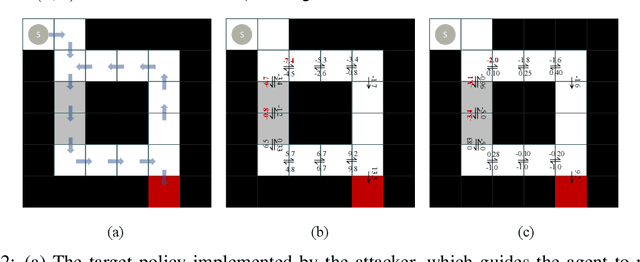

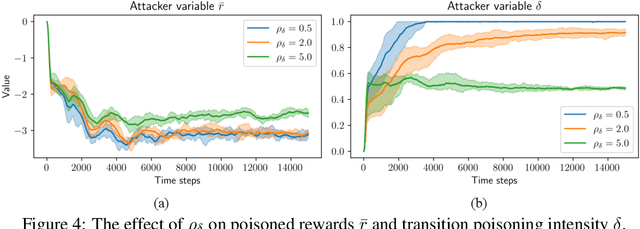
Abstract:This paper proposes an online environment poisoning algorithm tailored for reinforcement learning agents operating in a black-box setting, where an adversary deliberately manipulates training data to lead the agent toward a mischievous policy. In contrast to prior studies that primarily investigate white-box settings, we focus on a scenario characterized by \textit{unknown} environment dynamics to the attacker and a \textit{flexible} reinforcement learning algorithm employed by the targeted agent. We first propose an attack scheme that is capable of poisoning the reward functions and state transitions. The poisoning task is formalized as a constrained optimization problem, following the framework of \cite{ma2019policy}. Given the transition probabilities are unknown to the attacker in a black-box environment, we apply a stochastic gradient descent algorithm, where the exact gradients are approximated using sample-based estimates. A penalty-based method along with a bilevel reformulation is then employed to transform the problem into an unconstrained counterpart and to circumvent the double-sampling issue. The algorithm's effectiveness is validated through a maze environment.
BESTAnP: Bi-Step Efficient and Statistically Optimal Estimator for Acoustic-n-Point Problem
Nov 26, 2024
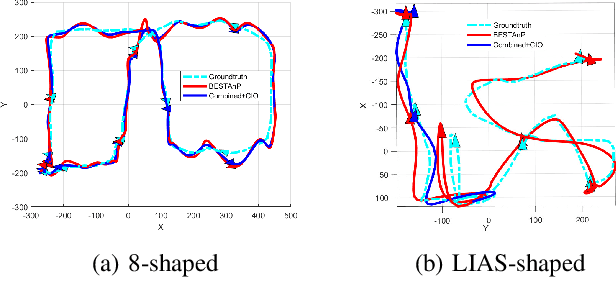
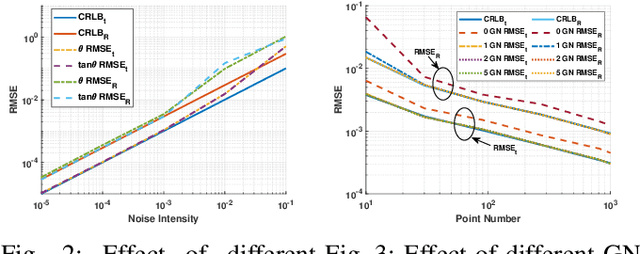
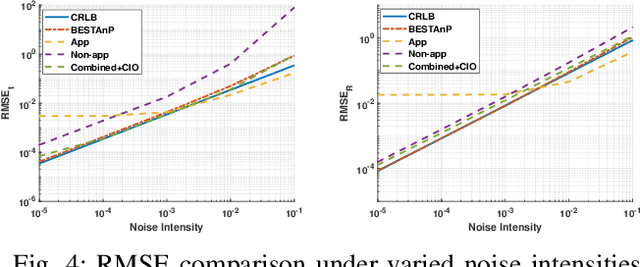
Abstract:We consider the acoustic-n-point (AnP) problem, which estimates the pose of a 2D forward-looking sonar (FLS) according to n 3D-2D point correspondences. We explore the nature of the measured partial spherical coordinates and reveal their inherent relationships to translation and orientation. Based on this, we propose a bi-step efficient and statistically optimal AnP (BESTAnP) algorithm that decouples the estimation of translation and orientation. Specifically, in the first step, the translation estimation is formulated as the range-based localization problem based on distance-only measurements. In the second step, the rotation is estimated via eigendecomposition based on azimuth-only measurements and the estimated translation. BESTAnP is the first AnP algorithm that gives a closed-form solution for the full six-degree pose. In addition, we conduct bias elimination for BESTAnP such that it owns the statistical property of consistency. Through simulation and real-world experiments, we demonstrate that compared with the state-of-the-art (SOTA) methods, BESTAnP is over ten times faster and features real-time capacity in resource-constrained platforms while exhibiting comparable accuracy. Moreover, for the first time, we embed BESTAnP into a sonar-based odometry which shows its effectiveness for trajectory estimation.
$S^2$NeRF: Privacy-preserving Training Framework for NeRF
Sep 03, 2024Abstract:Neural Radiance Fields (NeRF) have revolutionized 3D computer vision and graphics, facilitating novel view synthesis and influencing sectors like extended reality and e-commerce. However, NeRF's dependence on extensive data collection, including sensitive scene image data, introduces significant privacy risks when users upload this data for model training. To address this concern, we first propose SplitNeRF, a training framework that incorporates split learning (SL) techniques to enable privacy-preserving collaborative model training between clients and servers without sharing local data. Despite its benefits, we identify vulnerabilities in SplitNeRF by developing two attack methods, Surrogate Model Attack and Scene-aided Surrogate Model Attack, which exploit the shared gradient data and a few leaked scene images to reconstruct private scene information. To counter these threats, we introduce $S^2$NeRF, secure SplitNeRF that integrates effective defense mechanisms. By introducing decaying noise related to the gradient norm into the shared gradient information, $S^2$NeRF preserves privacy while maintaining a high utility of the NeRF model. Our extensive evaluations across multiple datasets demonstrate the effectiveness of $S^2$NeRF against privacy breaches, confirming its viability for secure NeRF training in sensitive applications.
Optimal camera-robot pose estimation in linear time from points and lines
Jul 23, 2024Abstract:Camera pose estimation is a fundamental problem in robotics. This paper focuses on two issues of interest: First, point and line features have complementary advantages, and it is of great value to design a uniform algorithm that can fuse them effectively; Second, with the development of modern front-end techniques, a large number of features can exist in a single image, which presents a potential for highly accurate robot pose estimation. With these observations, we propose AOPnP(L), an optimal linear-time camera-robot pose estimation algorithm from points and lines. Specifically, we represent a line with two distinct points on it and unify the noise model for point and line measurements where noises are added to 2D points in the image. By utilizing Plucker coordinates for line parameterization, we formulate a maximum likelihood (ML) problem for combined point and line measurements. To optimally solve the ML problem, AOPnP(L) adopts a two-step estimation scheme. In the first step, a consistent estimate that can converge to the true pose is devised by virtue of bias elimination. In the second step, a single Gauss-Newton iteration is executed to refine the initial estimate. AOPnP(L) features theoretical optimality in the sense that its mean squared error converges to the Cramer-Rao lower bound. Moreover, it owns a linear time complexity. These properties make it well-suited for precision-demanding and real-time robot pose estimation. Extensive experiments are conducted to validate our theoretical developments and demonstrate the superiority of AOPnP(L) in both static localization and dynamic odometry systems.
 Add to Chrome
Add to Chrome Add to Firefox
Add to Firefox Add to Edge
Add to Edge